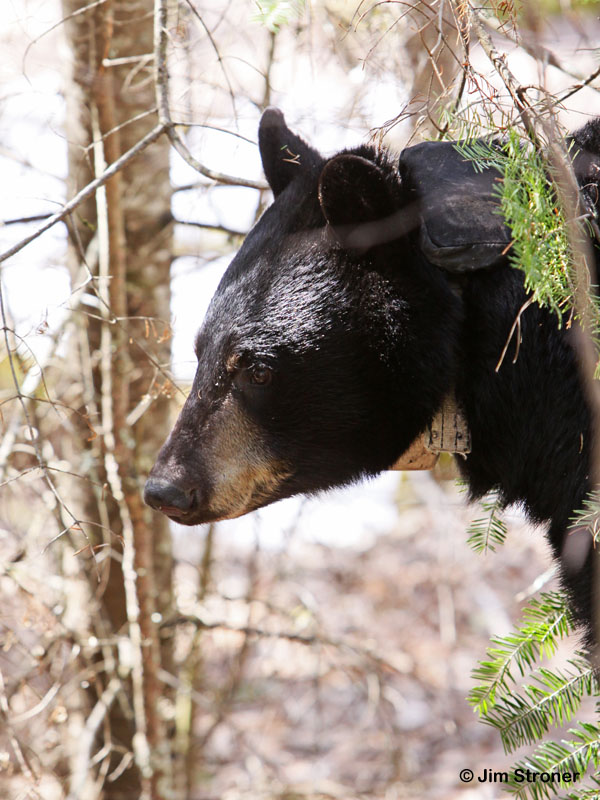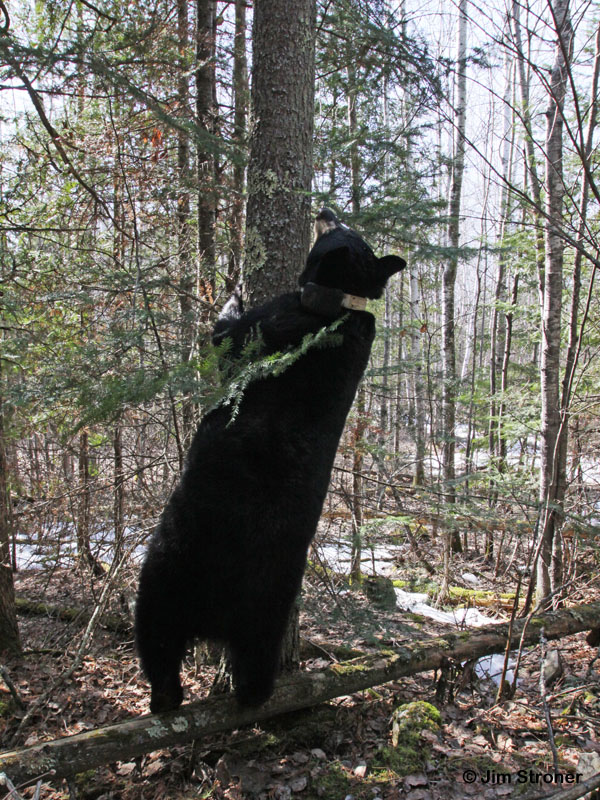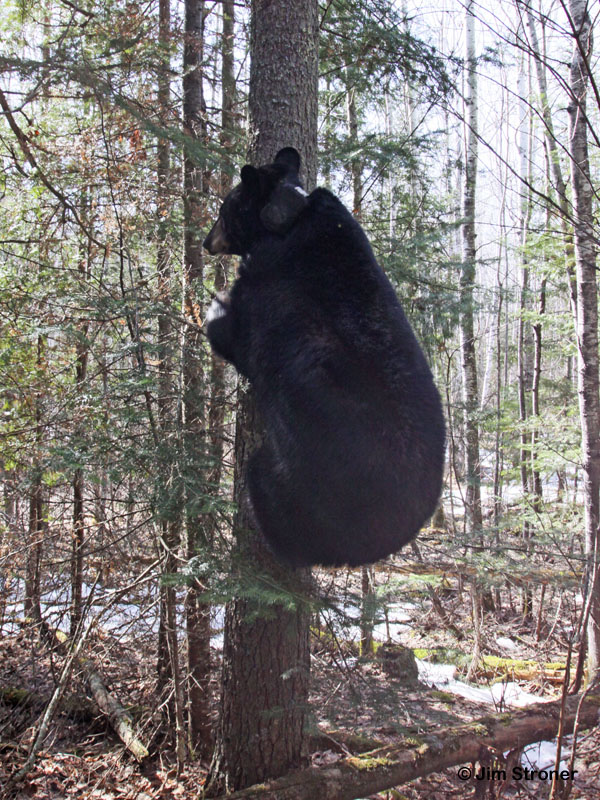April snow
 With 4 inches of new snow on the ground, Lily and Jo are not traveling much. Watching their movements on the computer, we stayed in and did paperwork. The pictures here of Jo were taken April 14.
With 4 inches of new snow on the ground, Lily and Jo are not traveling much. Watching their movements on the computer, we stayed in and did paperwork. The pictures here of Jo were taken April 14.
The latest on Jason is that the veterinarian completed a short report on the initial examination of Jason's body and released it to DNR officials. We have requested a copy. The complete report could take a week or two.
 With those thoughts in mind, we want to show people how small cubs are when they leave the den in order to help people understand bear behavior during that vulnerable period. The more people know about bears and their challenges, the more people will see bears as something other than the ferocious media image. We think that if people can see all stages of their lives they will have more questions, learn more, and be more willing to coexist. We may or may not identify him as Jason in the display. Lily fans will know. To others, years from now, the exhibit may simply be a generic mother and tiny cub with words and video about the challenges cubs face.
With those thoughts in mind, we want to show people how small cubs are when they leave the den in order to help people understand bear behavior during that vulnerable period. The more people know about bears and their challenges, the more people will see bears as something other than the ferocious media image. We think that if people can see all stages of their lives they will have more questions, learn more, and be more willing to coexist. We may or may not identify him as Jason in the display. Lily fans will know. To others, years from now, the exhibit may simply be a generic mother and tiny cub with words and video about the challenges cubs face.We are learning that mixed-age litters present special challenges. A year ago, all anyone knew was that the occasional bear family included an older sibling, which showed that cubs can survive in the presence of a yearling. Beyond that, no one knew what brings about that situation or how they relate in the den and out. Hope showed us that yearlings do not just sleep when there are new cubs in the den.
Is one of the challenges for the new cubs unfair competition for milk? We saw that Hope did not dominate all the nipples. She and they established a nipple order with Hope on the right and Faith and Jason on the left. When it was time to nurse, they each took their usual spots with little strife.
The most common litter size around Ely is three. Hope probably took more than her share of milk because she controlled two nipples while Faith and Jason each controlled one. However, the cubs were small enough that one nipple was likely adequate at the time.
 Did Hope stimulate higher production of prolactin to increase milk supply? Or did Hope drain Lily’s body stores and reduce the milk available for the new cubs? It was interesting that Faith and Jason were the same apparent size despite nursing from different sized nipples. Was the fact that Jason nursed from a smaller mammary related to his slower development of skills? Or is there another explanation? Did Hope’s rough-house play deprive him of sleep and slow development?
Did Hope stimulate higher production of prolactin to increase milk supply? Or did Hope drain Lily’s body stores and reduce the milk available for the new cubs? It was interesting that Faith and Jason were the same apparent size despite nursing from different sized nipples. Was the fact that Jason nursed from a smaller mammary related to his slower development of skills? Or is there another explanation? Did Hope’s rough-house play deprive him of sleep and slow development?
Did Hope injure Jason by mouthing him and not being fully able to control the power of her bite? Lily mouthed her the same way last year, but an adult bear can control their bite very well. We know that ability is well developed by a year and a half. Cubs, on the other hand, can bite too hard during play. Hope showed us that she was already learning to control her bite by 12 months of age as evidenced by the fact that she repeatedly mouthed the newborn cubs without killing them and seldom even making them yelp. They did yelp at times, though, and we wondered what that meant. It’s possible she inflicted injuries.
Another challenge for the new cubs was that Lily was often distracted by Hope’s desire to play. Did that take away nursing time? The Den-watchers will help provide data on that to compare with last year.
Now that they are out of the den, will Hope’s mobility influence Lily to travel more than if she only had Faith? Lily is more than a mile from their den, while Jo and her cub are only three tenths of a mile from theirs. However, Lily et al spent the last three days in a very small area after their mile-long journey.
The death of Jason makes us ask, “If Hope wasn’t there, would Jason still be alive? That’s very possible. Should we have let Hope die? Opinions vary.
We remember the questions of last summer. Did Lily make a conscious decision to leave Hope because she knew Hope was defective? Hope is showing us that she is thriving and has nothing obviously wrong with her. And Lily’s leaving did not appear to be a conscious decision to reject Hope. When Lily saw Hope, she embraced her, nursed her, and played with her. The emotion of the reunion was obvious.
We believe that Lily had one problem last year. One cub did not provide enough suckling to prevent Lily from ovulating. Lily had conflicting drives due to conflicting hormones. The urge to mate took over. When mating was over, she found Hope and became a mother again, complete with renewed lactation.
What would have happened if we didn’t supplement Hope’s diet during the six weeks of separation? She may or may not have survived. Survival was likely because she was near enough houses that she would likely have ended up in someone’s yard and been fed, but we thought that wouldn’t be the best thing for her. We thought it better that she be foraging in the wild around the area we provided supplemental food.
People have been feeding bears in Hope’s township since at least 1961. One of our major areas of study is the behavior of bears with that kind of access to supplementary food. What the bears are showing is contrary to most of the traditional concerns about feeding. The supplemental feeding as done in this township is functioning as diversionary feeding and showing itself to be a potentially powerful tool in reducing bear-human conflict. The very study of that topic challenges the dogma of established (although unfounded) beliefs and brings immense criticism.
Should we have studied this in a vacuum to avoid public criticism? Or should we have done what we did—share the journey and let anyone interested learn along with us?
Linda Gibson is working to create den cam videos from those days she missed. Please check for recent ‘bearstudy’ video uploads on YouTube at http://www.youtube.com/user/bearstudy#g/u.
We’re going through a hard time at this point, but we are moving forward with your support.
Thank you for all you do.
—Lynn Rogers and Sue Mansfield, Biologists, Wildlife Research Institute and North American Bear Center
